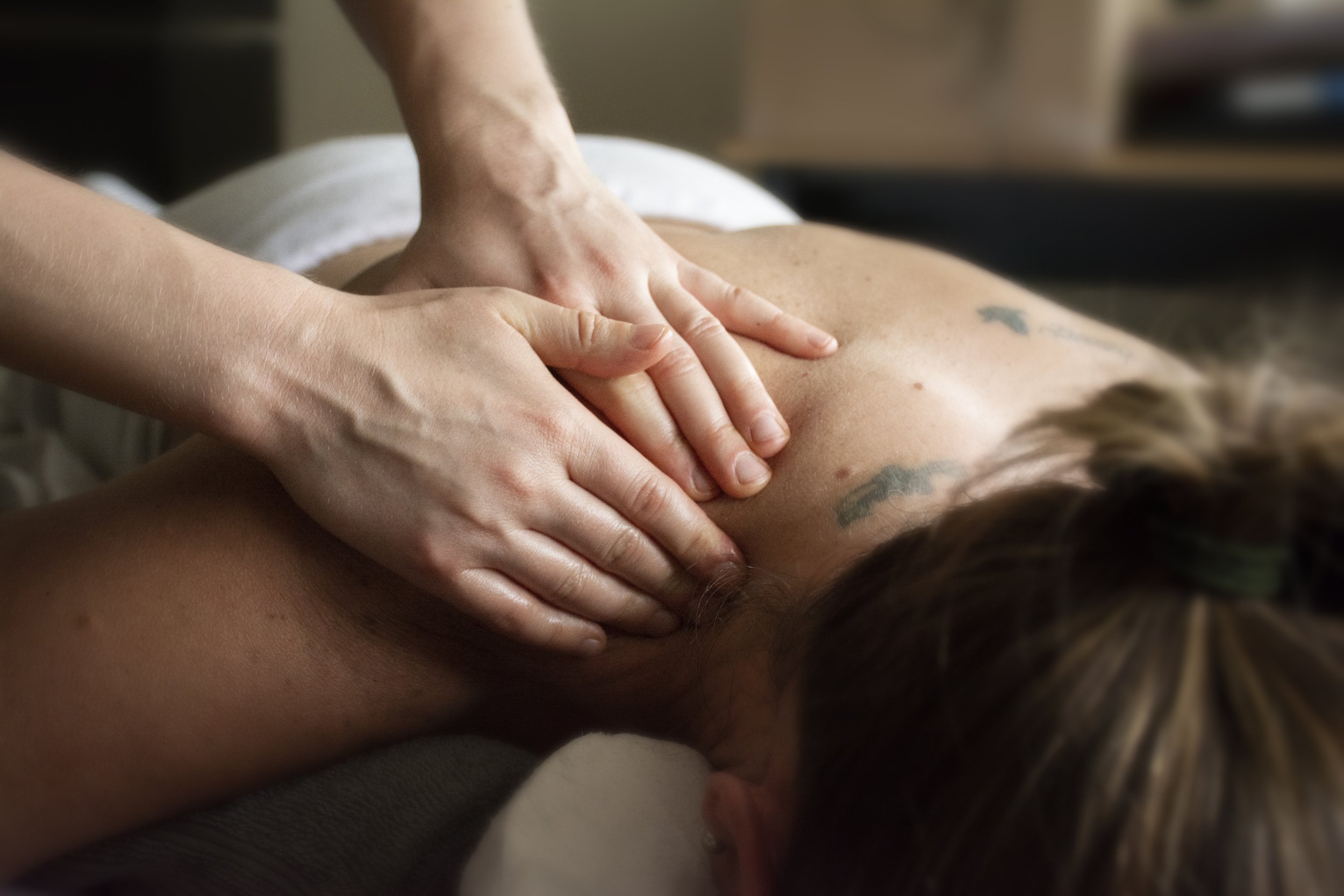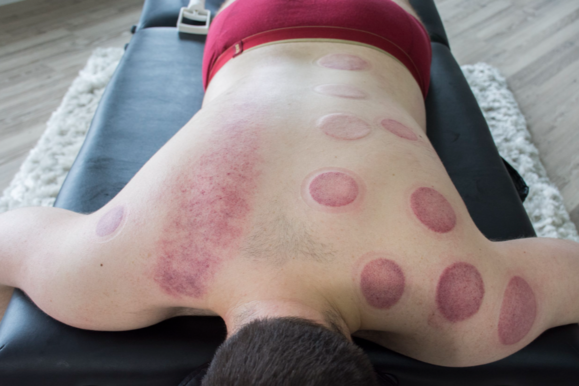
CUPPING Edmonton
Cupping Therapy Edmonton
A satisfying myofascial release based therapy using suction from cups that anchor to the skin and create blood flow to superficial and deep layers of connective tissue. Feel a gratifying rush of warmth and flexibility to those concentrated areas when the cups are removed.
Cupping therapy has been used for centuries to promote healing and relieve pain. It is a safe and non-invasive treatment that can be used in conjunction with other therapies to improve overall health and well-being. There is a lot of value in receiving myofascial cupping in conjunction with other traditional deep tissue or therapeutic based massage therapy, and we'll highlight the benefits as well as bust the myths on this page. So, keep reading to learn if cupping is right for you!
A common question we get asked with someone who's never experienced cupping before is, what does cupping feel like? More specifically, does cupping hurt or will it create painful or tender bruising? Firstly, we'll address what myofascal cupping is. The purpose of myofascial cupping, and why it's typically known as a myofascial, or fascial technique, is because the negative suction from the silicone, or plastic cup being placed on the skin, gently lifts the most superficial layer of fascia (the system, or network that contains and binds your muscles together into different groups) from the deeper layers, which allows for blood flow, as well as a controlled, and purposeful inflammatory response to the localized area where the cup is placed, which creates microtrauma to the capillaries; this is what people misunderstand to be “bruises”. We actually want this, it's a good thing!
It allows for the lymphatic system to kick in, taking extra fluid, and cells that are using up unnecessary energy from your body to be expelled out of the system, helping your metabolic processes focus more efficiently on other processes your body needs it for, and creating more mobility and fluid to flow through your joints. Cupping actually also feels good and absolutely does not create bruising! It feels like a slight pull to the skin that may feel temporarily and briefly tingly, a little itchy, or tight, but it should not feel painful. It might initially sting for the first few seconds, to approximately 15 seconds, but the sensation should dissipate quite quickly.
Please communicate to your massage therapist if the tingling, pulling or tight sensation is not dissipating, and definitely if the sensation is intensifying. Your massage therapist is there to regulate the pressure, and monitor the progress of the discoloration that happens under the cups, but we are not in your body! We value and welcome any and all feedback about sensations that you'd like to offer.
The sensation of tingling, itchiness or tight pulling of the skin should subside fairly quickly during a massage treatment; like we said, it's different for every person, but could be within 15 seconds or so. We can't stress this enough; it's encouraged to communicate with your practitioner if you are too uncomfortable at any time! Sometimes clients come in, assuming that the feeling of more intensity, or sensation, is better, and they need to "grit their teeth and bear it", but this is absolutely not true. We encourage our clients to breathe deeply into the feeling of the sensation, and come to that "edge" but without major discomfort. When you breathe deeply, and use your diaphragm, this is also creating a gentle release under the cups, which allow for further release without the massage therapist's intervention (which can mean, mobilizing, or moving the cups around, increasing the sensation by increasing the suction of the cups, or other techniques to increase the cupping treatment's effectiveness.
Dynamic Cupping
Many clients aren't aware that there are two different types of myofascial cupping that we utilize at the Strive Holistic massage clinic. There’s static cupping, and dynamic (also known as sliding) cupping. There's also fire cupping, but we do not perform that service at this clinic. Static and dynamic cupping both have the function of improving blood flow, and creating microtears between the layers of fascial tissue in order to promote localized and controlled inflammation for the purpose of healing, but the sensation on the skin is a little different, and the results achieved are slightly different. Read more below to understand the difference between these two myofascial cupping treatment types.
Static cupping is when the cups remain anchored on the skin, anywhere from 2 to 10 minutes, depending on the client’s needs for localized blood flow in the area. The cup marks will sometimes appear darker, simply because the cups have a longer time to dredge up deoxygenated blood and extracellular tissue from underneath the deeper layers, the longer they stay anchored to the skin.
Static Cupping
Dynamic cupping is when the suction is slightly reduced, but the practitioner moves the cups, which allows for a larger amount of space on the client’s body to be covered, but may not penetrate as deep into the tissues. Both types of cupping are beneficial and are for different purposes. Static cupping, since the cups are placed in one spot for longer, can lift up toxins from deeper layers of fascia locally to promote oxygenation. Dynamic cupping however, is possible more appropriate for a joint mobility and range of motion technique, since more area can be covered on and around the joint being worked. The request for dynamic cupping is more common of the client is very resistant to the markings that can appear on the skin, which is completely okay!
There are also different colours that can arise in the skin when cups are placed!
The colours of your cup marks can be very telling to the practitioner and can indicate different things. A cup mark that is very dark red, for example, can indicate de-oxygenated and stagnant blood that is slowing down your metabolic rate and is no longer needed by the body and needs the suction of the cup to be assisted in being given the space needed so that it can be expelled from the body, whereas a pale cup mark can indicate lack of blood flow in that joint or localized area of tissue. Ask your practitioner about cupping during your next massage therapy treatment! Did you know we offer cupping in combination with our Acupuncture treatments as well? Our Acupuncturists offer cupping, in combination with their acupuncture treatments. Learn more on our Acupuncture page!
Still have questions or concerned about myofascial cupping? We invite you to visit our FAQ page for commonly asked questions, or reach out to us directly via email at info@striveholistic.com to learn more about cupping and if it's a good fit for you!
Dynamic Cupping
Dynamic cupping is when the suction is slightly reduced, but the practitioner moves the cups, which allows for a larger amount of space on the client’s body to be covered, but may not penetrate as deep into the tissues. Both types of cupping are beneficial and are for different purposes. Static cupping, since the cups are placed in one spot for longer, can lift up toxins from deeper layers of fascia locally to promote oxygenation. Dynamic cupping however, is possible more appropriate for a joint mobility and range of motion technique, since more area can be covered on and around the joint being worked. The request for dynamic cupping is more common of the client is very resistant to the markings that can appear on the skin, which is completely okay!
There are also different colours that can arise in the skin when cups are placed!
The colours of your cup marks can be very telling to the practitioner and can indicate different things. A cup mark that is very dark red, for example, can indicate de-oxygenated and stagnant blood that is slowing down your metabolic rate and is no longer needed by the body and needs the suction of the cup to be assisted in being given the space needed so that it can be expelled from the body, whereas a pale cup mark can indicate lack of blood flow in that joint or localized area of tissue. Ask your practitioner about cupping during your next massage therapy treatment! Did you know we offer cupping in combination with our Acupuncture treatments as well? Our Acupuncturists offer cupping, in combination with their acupuncture treatments. Learn more on our Acupuncture page!
Still have questions or concerned about myofascial cupping? We invite you to visit our FAQ page for commonly asked questions, or reach out to us directly via email at info@striveholistic.com to learn more about cupping and if it's a good fit for you!


